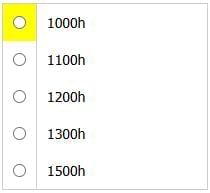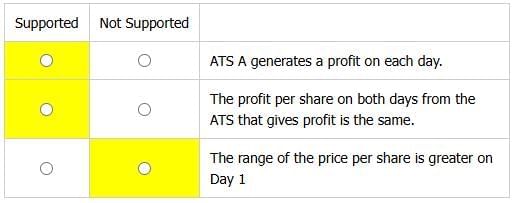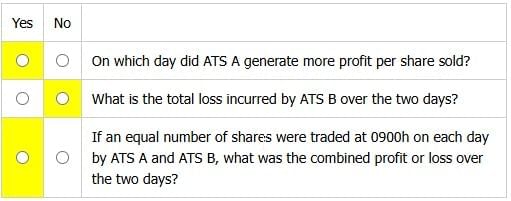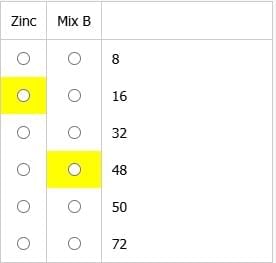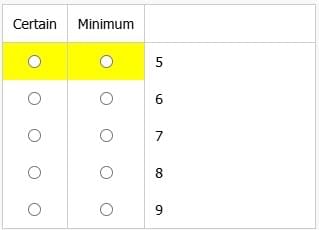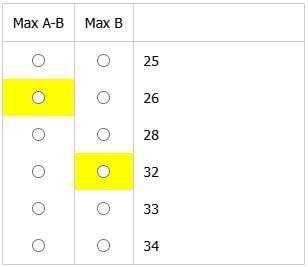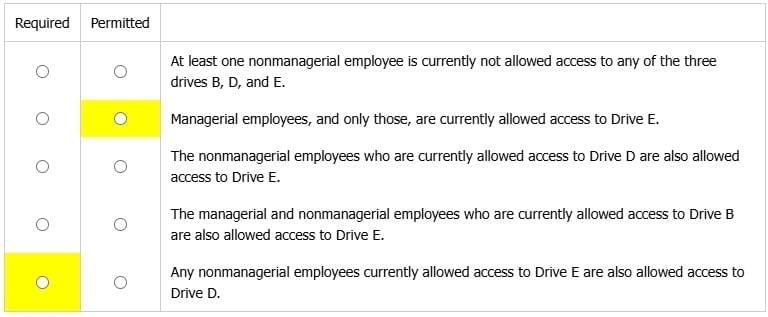Test: Data Insights - 6 - GMAT MCQ
20 Questions MCQ Test GMAT Mock Test Series 2025 - Test: Data Insights - 6
The maximum percentage increase in the price of a share on Day 2 compared to Day 1, at exactly the same time on both days, was at:
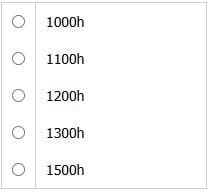

For each of the following statements, Choose'Supported' if the statement is true according to the information provided. Otherwise, choose 'Not Supported'
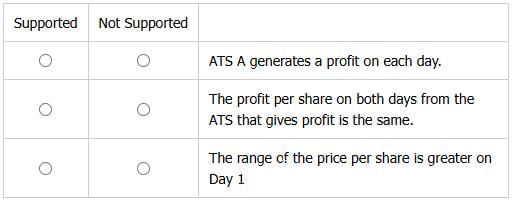

For each of the following statements, select 'Yes' if the question can be answered based on the information in the passage. Otherwise, select 'No'
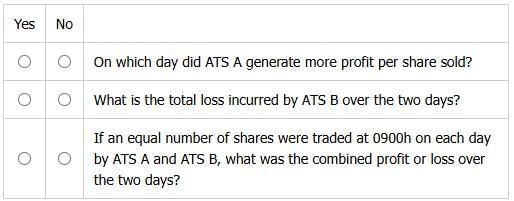

Brass is an alloy of copper and zinc whose proportions can vary to achieve different properties. Mix A, which weighs 50 kg, consists of 66% copper and 34% zinc in one such blend. This mix must be adjusted to increase its hardness by adding the maximum possible amount of zinc while ensuring that the zinc content does not exceed the weight of the copper in the new mix. Another blend, Mix B, contains 40% copper and 60% zinc and can be combined with Mix A to achieve the desired proportion.
Choose the weight of pure zinc in kg that would be added by combining Mix A with either zinc alone or with Mix B to meet the above requirement.
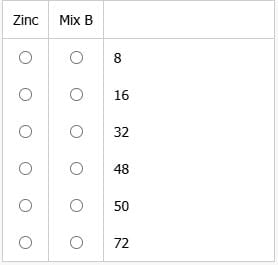
A bag contains 20 fruits of three types: apples, bananas, and oranges. Each type appears in a different quantity. The probability of picking any type of fruit is greater than 1/5 but less than 1/2
Choose for Certain a number that must represent the count of one type of fruit in the bag, and choose for Minimum a number that represents the smallest possible count of a type of fruit.
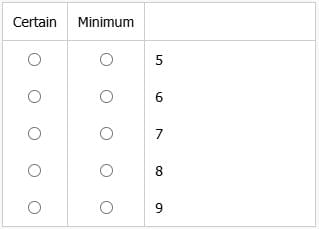
The class teacher divided 100 pencils amongst five students, A, B, C, D and E. The number of pencils received by A is equal to the sum of the pencils received by the three students, C, D and E. It is also known a ≥ b ≥ c ≥ d ≥ e, where a, b, c, d and e are pencils received by A, B, C, D and E respectively.
On the basis of the information provided, Choose for Max A-B, the maximum difference between the number of the pencils received by A and the number of the pencils received by B, and choose for Max B the largest number of the pencils that B could have got.
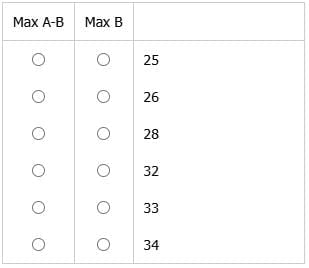
A basket contains apples and oranges only. If 2 fruits are randomly selected from the basket one after another without replacement, what is the probability that at least one of them is an apple?
(1) The number of oranges in the basket is twice the number of apples.
(2) If 2 fruits are randomly selected from the basket one after another with replacement, the probability that at least one of them is an apple is 5/9.
What is the length of Train A if it crosses Bridge X in 30 seconds from the moment it enters the bridge to the moment its final carriage exits the bridge?
(1) Train B, which is 200 meters long, traveling at a constant speed of 20 meters per second, crosses Bridge X in 40 seconds.
(2) The end of Train A, which is traveling at a constant speed, passes a pole in 10 seconds from the moment the train meets the pole.
Marco is making z pizzas and will distribute x slices of pepperoni to the pizzas so that every pizza has the same number of slices of pepperoni. If the number of slices of pepperoni is more than three times the number of pizzas but less than eight times the number of pizzas, and Marco will make at least four pizzas, what is the number of slices of pepperoni Marco uses?
(1) If Marco makes 2 fewer pizzas than he does, he would be able to distribute the x pepperoni slices evenly among them.
(2) If Marco makes 5 more pizzas than he does, he would be able to distribute the x pepperoni slices evenly among them.
A hotel has 80 rooms and charges the same amount per night for each occupied room. This is the hotel's only source of revenue. In September, the average (arithmetic mean) number of rooms occupied per night was 60. How many nights in September were all the rooms in the hotel occupied?
(1) On the nights when not all the rooms of the hotel were occupied, the average number of rooms occupied was 40.
(2) In September, the total revenue for the nights when all the rooms of the hotel were occupied was twice the revenue for the nights when not all the rooms were occupied.
A group of people is seated at a table at which a toast is made. Following the toast, each person must clink glasses exactly once with each of the other people at the table. If each clink is produced by the glasses of only two people, how many people are seated at the table?
(1) If two fewer people were seated at the table, there would be at least 17 but no more than 19 fewer clinks.
(2) If two more people were seated at the table, there would be at least 18 but no more than 21 fewer clinks.
Each correctional facility in a certain state has the same number of interns, and each facility has interns of each sex. If Lockwood Correctional Facility has 22% of the female interns in the state, does it have less than 20% of the male interns?
(1) Lockwood has between 18% and 22% of the state's male interns.
(2) Lockwood has more female interns than does any other facility in the state.
Revenue Share of Most Popular Pizzas
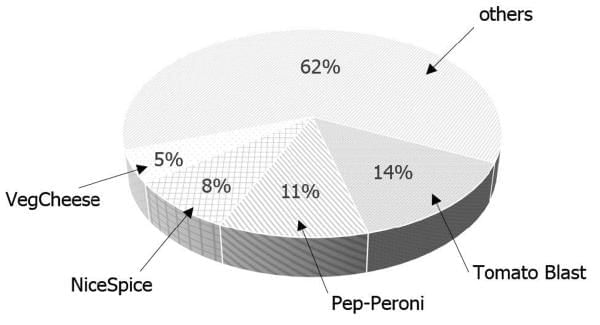
A certain pizzeria has more than fifty types of pizzas on its menu. The chart shows the revenue share, in the pizzeria’s total revenue in the last month, of its four most popular pizza types. Each pizza type has only a single size and a single price.
Which was their best-selling pizza last month in terms of number of pizzas sold?
(1) The number of customers who ordered at least one Pep-Peroni pizza last month was greater than the number of customers who ordered at least one of any other pizza type last month.
(2) The lowest-priced pizza type on the pizzeria’s menu is Tomato Blast, followed by VegCheese.
A school district surveyed 100 parents to gather their opinions on the district's budgetary priorities. The table shows the percentages of all survey respondents who indicated that they strongly agreed, somewhat agreed, somewhat disagreed, or strongly disagreed that each of the four actions should occur. No other response options were available. No respondent could choose more than one response option for each action. Not every respondent gave an opinion for every activity.
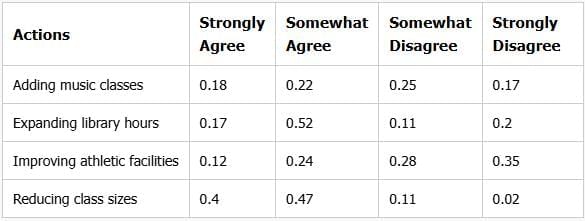
For each of the following questions, choose if the answer to that question can be determined from the information given. Otherwise, choose Cannot be determined.

The table shows, for each of 10 Irish weather stations and each of 8 calendar months, the average (arithmetic mean) number of days per month that the station recorded snowfall during the years 1961–2000. For example, during this time period, the station at Birr recorded snowfall on an average of 4.5 days in January.
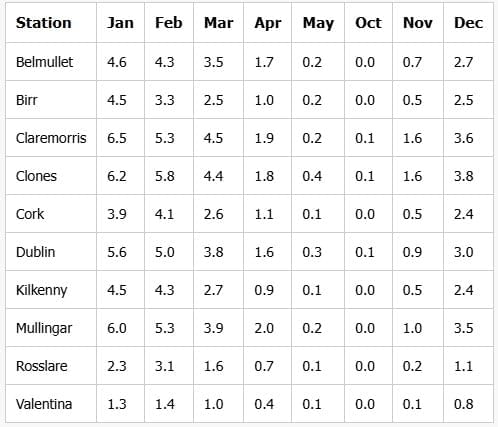
For each of the following statements about the weather stations listed in the table, chooset Must be true if that statement must be true if the information provided is correct. Otherwise, choose Might not be true.

For each of the following values, Choose Could be x if that exact value for x is consistent with the information provided. Otherwise, choose Cannot be x.or each of three years and five survey prompts, the table shows the percentage of respondents to a job-satisfaction survey who agreed with the prompt. For columns showing pairs of years in the top row, a minus sign (–) or plus sign (+) for a prompt indicates that the change in the percentage of respondents from the first year to the second represents a significant decrease or significant increase, respectively. For the difference in the number of percentage points to be considered significant, its absolute value must be greater than a certain number, x. Although the percentages in the table are rounded to the nearest percentage point, whether a change is significant is determined using the raw percentages prior to rounding.

For each of the following values, choose Could be x if that exact value for x is consistent with the information provided. Otherwise, choose Cannot be x.
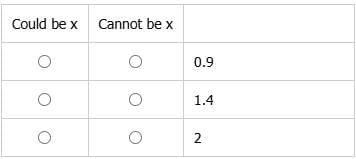
The following tables show the data on “tertiary education”
Note that “tertiary education” means all education following high school level: undergraduate as well as graduate studies. Here, “in tertiary education” includes those now enrolled in those programs, as well as all who have completed degrees. Note, also, many of the countries in the table have a high percent of total students in the table, and therefore rank considerably lower in public spending per tertiary student: countries with comparatively few students at the tertiary level rank much higher than the countries listed in the table.
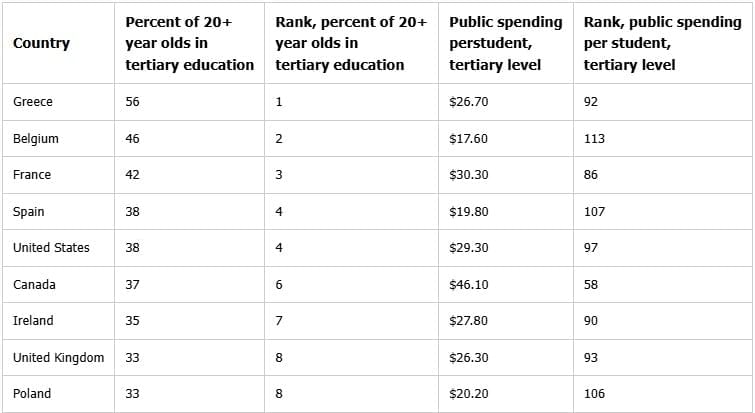
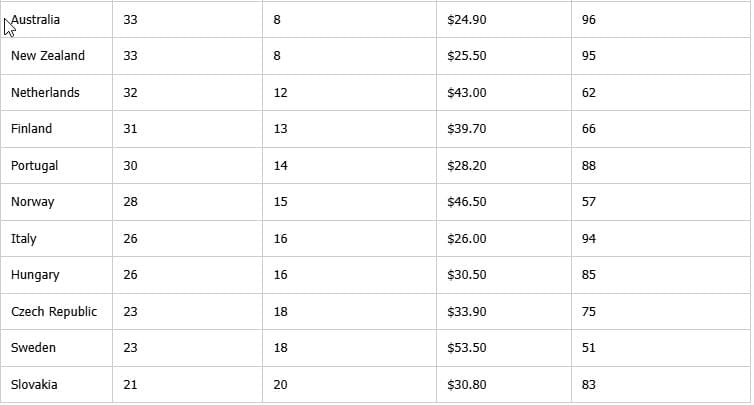

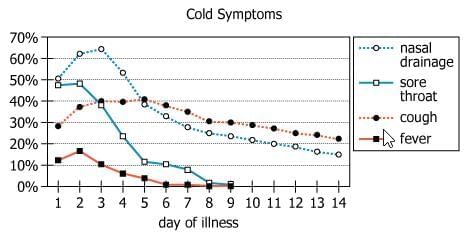
For each of four symptoms, the graph shows the percentage chances that someone will have that symptom on each day of the 2 weeks after first developing a cold. The lines for certain symptoms do not continue past a certain day because the chance that someone will have those symptoms beyond that day is less than 1%.
Choose the options (A) and (B) that create the statement that is most strongly supported by the information provided.
It can be determined from the graph that the probability is greater than 0.98 that someone with a cold will have ___(A)____ of the four symptoms on day ___(B)____
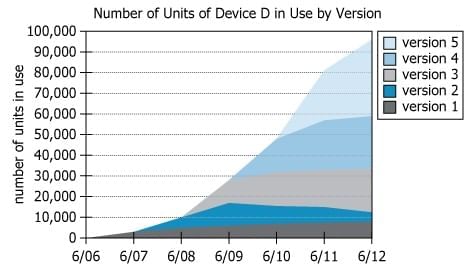
As of the beginning of June 2012 (6/12), Device D (an Internet-connected device) was available in exactly 5 versions. Version 1 became available at the beginning of June 2006 (6/06), and a new version became available at the beginning of each subsequent June, with Version 5 becoming available at the beginning of June 2010 (6/10). The graph shows the number of units of Device D in use, by version, at the beginning of each June from 2006 through 2012. For example, at the beginning of June 2008 (6/08), there were approximately 10,000 units of Device D in use, approximately 5,000 of which were Version 1 and approximately 5,000 of which were Version 2.
Based on the information above, choose the option (A) and (B) that completes the statement most accurately.
During the first calendar year throughout which the graph suggests a decrease over time in the number of devices in use of Version _____(A)____, Version _____(B)____ became available.
To ensure computer security, a firm has rules about access of managerial and nonmanagerial employees to various networked computer drives. In accordance with the rules, some but not all nonmanagerial employees are allowed access to both Drive B and Drive D. Some are required to have such access. Every nonmanagerial employee must have access to at least one of Drive B and Drive D. No nonmanagerial employee is allowed to have access to both Drive B and Drive E. The rules do not restrict the access of managerial employees to any of the drives mentioned.
From the following statements about computer security practices in relation to the firm's employees, select for Required the statement that, based on the information provided, describes a practice that is required by the rules, and select for Permitted the statement that describes a practice that is permitted, but NOT required, by the rules. Choose only two selections, one in each column.
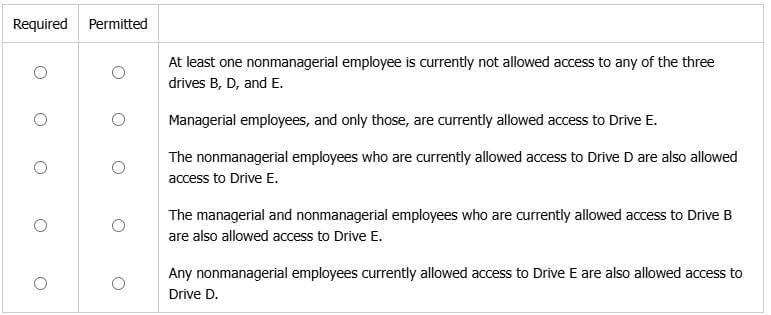
|
18 docs|33 tests
|


